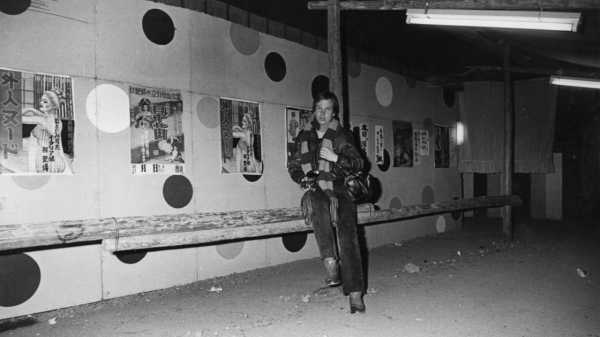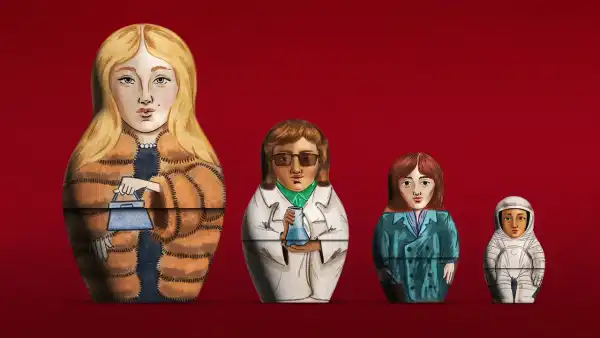
I stumbled into Japan by accident. Asian culture had played no part in
my childhood in Holland, even though the Hague, my home town, still had
a nostalgic whiff of “the Orient.” People returning from the East Indian
colonies used to retire there in large nineteenth-century mansions near
the sea, complaining of the cold and damp climate, missing the clubs,
the tropical landscapes, and the servants. I liked Indonesian food, one
of the few reminders of the recent colonial past, and the peculiar
Indo-Dutch variety of Chinese cuisine: fat spring rolls, thick and oily
fried noodles with a sambal sauce made of chilies and garlic, the
delicacy of the original coarsened by the greed of northern European
appetites. My father’s elder sister had the misfortune of being sent to
the Dutch East Indies, as a nanny, just before the Second World War; she
ended up spending most of her time in a particularly grim Japanese
P.O.W. camp. So no nostalgia there.
But ever since I can remember, I dreamed of leaving the safe and
slightly dull surroundings of my upper-middle-class childhood, a world
of garden sprinklers, club ties, bridge parties, and the sound of tennis
balls in summer. I was prejudiced from an early age against my native
country. I grew up with two cultures: lapsed Dutch Protestant on my
father’s side, assimilated Anglo-Jewish on my mother’s. I could “pass”
in both, but never felt naturally at ease in either. My destiny was to
be half in, half out—of almost anything. Passing was my default state.
In the meantime, there was never any doubt in my mind that glamour was
always somewhere else—in London, especially in my uncle’s house, when I
was still living in Holland, but preferably somewhere farther afield.
By the time I was liberated from school and living, for a year, in
London, being “into Asia” had become a fashionable attitude: hippie
trips to India in a Volkswagen bus, a superficial acquaintance with Ravi
Shankar’s sitar music, the cloying smell of joss sticks in tea shops
selling hash paraphernalia. But my interest in Japan, in particular,
began around 1972 or 1973, when I first saw a performance of the theatre
group Tenjo Sajiki, at the Mickery Theatre, in Amsterdam. Mickery,
located in a former cinema, was for some years a mecca of avant-garde
theatre from all over the world. The young Willem Dafoe performed there,
as did groups from Poland, Nigeria, and most of the artistic capitals of
the West.
Tenjo Sajiki, whose name translates to “the seats near the ceiling,” was from Tokyo. The
founder and director, Terayama Shuji, an aloof but charismatic figure
dressed in dark suits and blue high-heeled denim shoes, was a poet,
playwright, essayist, novelist, photographer, and filmmaker. Terayama’s
plays and movies owed something to various Western influences—a bit of
Fellini here, Robert Wilson there—but far more to Japanese fairground
entertainments, carnival freaks, striptease shows, and other forms of
theatrical lowlife.
Seeing Tenjo Sajiki for the first time was like squinting through the
keyhole of a grotesque peep show. I had never seen anything remotely
like it. The first play I witnessed at the Mickery, in 1972, was
entitled “Ahen Senso,” or “Opium War.” Less a coherent story than a
series of tableaux, “Opium War” was staged outside the theatre, as well
as inside, where the public was led by guides into rooms decorated with
old Japanese movie posters, blown-up details of erotic woodblock prints,
lurid comic books, and props that seemed to have been lifted from a
nineteen-twenties whorehouse. Naked women were displayed in a variety of
peculiar poses, and ventriloquists in chalky Kabuki makeup performed
while being whipped by a dominatrix reciting a Japanese poem and wearing
a black S.S. cap. One naked man had Chinese characters tattooed all over
his body. A beautiful young girl in a purple dress cut the head off a
live chicken.
The air of violence and the fact that, at certain times, we were boxed
into metal cages caused an older man in the audience to panic; it
reminded him of his incarceration, as a child, in a Japanese P.O.W.
camp. There were rumors of fistfights between actors and the public,
which suited Terayama’s vision of theatre as a kind of criminal
enterprise. All this was accompanied by music, sometimes soft and
seductive, sometimes deafening and faintly sinister. It was deeply
weird, largely unintelligible, perversely erotic, rather frightening,
and totally unforgettable.
After the performance, the young actors gathered in the café. But since
only a few of them spoke English the barrier between performers and
public was barely breached. They were dressed like hip young
Westerners—jeans, leather jackets, boots, velvet pants. But some also
wore wooden Japanese sandals, called geta, and padded kimono jackets. I
was then studying Chinese at the local university, and going back to the
leaden prose of “Red Flag” or the Confucian classics seemed a letdown
after Terayama Shuji and his troupe. To Tokyo, I thought. As soon as
possible.
I had assumed that Terayama’s spectacles were the madly exaggerated,
surreal fantasies of a poet’s feverish mind. But what astonished me
about Tokyo, on visiting it for the first time, in the fall of 1975, was
how much it resembled a Tenjo Sajiki theatre set. There was
something theatrical, even hallucinatory, about the cityscape itself,
where nothing was understated: products, places, entertainment, and
fashion screamed for attention. In Tokyo, it seemed, very little was out
of sight.
I never thought that I could be Japanese, nor did I wish to be. But I
was open to change. This meant, in the early stages of my life in Japan,
almost total immersion. In the first few weeks, I walked around in a
daze, a lone foreigner bobbing along in crowds, taking everything in. I
walked and walked, often losing my way in the maze of streets in
Shinjuku or Shibuya. Much of the advertising was in the same intense
hues as the azure skies of early autumn. And I realized now that the
colors in old Japanese woodcuts were not stylized at all, but an
accurate depiction of Japanese light.
My immersion was partly a flight from bourgeois gentility, even if it
was also superficial, voyeuristic, semi-detached. I photographed the
back streets of Shinjuku, in the style of Moriyama Daido, who got much
of his inspiration from the American William Klein. My preferred route
through the city ran from Minami Senju, where a small, neglected
cemetery marked the Edo Period execution grounds, through Sanya, the
skid row, where labor contractors picked up homeless men for
construction jobs every morning, and on to Yoshiwara, the once elegant
red-light district that had decayed into a warren of neon-lit massage
parlors.
There was an old tumbledown theatre in Minami Senju, home to one of the
last troupes of travelling players, who performed crude versions of
famous Kabuki plays. In between acts, the players changed into Hawaiian
shirts and belted out pop songs through faltering microphones, while
others twanged on badly tuned electric guitars. I spent many hours in
that theatre, taking pictures of the actors, and of the audience: the
local butcher and his stocky wife, a petty crook or two, roof builders,
construction workers, dumpling cooks. God only knows what they thought
of the young foreigner snapping away at their feet. But they were always
welcoming in a politely amused sort of way.
One weekend, my friend Graham and I followed the actors on one of their
rural tours. We stayed the night at a seedy hot spring resort, called a
“Green Center,” where old folks would gather to drink and be
entertained. Dressed in thin summer kimonos, we sat at long wooden
tables laden with rice balls, dried squid, pickles, and miso soup,
watching a scene of murder committed by a famous nineteenth-century
brigand, followed by a famous love scene from a creaky samurai drama.
All the while, I was creeping around taking pictures.
The author in Chichibu, Saitama Prefecture, during his years in Japan.
Photograph by Sumie Tani
When it was time for a soak in the large communal bath, men and women
shed their summer wear and beckoned Graham and me to join. The tiled
bathroom had the stench of rotten eggs, and Mount Fuji on the wall was
half-obscured by steam coming off the water. After a quick wash, Graham
and I slid gingerly into the bath, with all eyes on us. We could not
have been more immersed in Japan, I thought, when a sudden burst of
cackling laughter creased the wrinkled country faces around us. “Look at
those pricks!” one of the oldest ladies in the bath shrieked. “Look at
those foreigners’ pricks!” “Ooh, aren’t gaijin white!” another
exclaimed, as though she had never seen anything so grotesque in her
life. “Just like tofu.”
Not long after this excursion, I came across another group of
entertainers, even lower down the social scale. I was joined by
Tsuda, a brilliant dropout student with a fringed Beatles haircut, who
would become my chief guide in Japan. We had set off on a cold November night, during Tori-no-Ichi, the harvest festival when, for twelve days, street markets are
laid out near temples and shrines. This is where the Human Pump had
set up his brown-and-green striped carnival tent, featuring such
curiosities as the snake woman, the girl who bit off the heads of live
chickens, and the hairy wolf man.
The main act was the Human Pump himself, an albino male of about forty.
First, he would swallow a number of shiny black and white buttons. The
public was then asked to call out “white” or “black,” and the Human Pump
would blink his pale eyes and spit out a button of the requisite color.
His pièce de résistance was the goldfish act, in which he would swallow
a live orange goldfish, then a yellow one, and shake his head a few
times to let them slide smoothly through his gullet. “Orange!” cried the
crowd. His face would fall into intense concentration, and the right
goldfish would come jetting out of his mouth.
These were modest skills, perhaps. Seen from backstage, the secret of
the Snake Woman became apparent when I noticed that her lower body was
made of bamboo and papier-mâché. I’m still not sure how the Human Pump
managed to regurgitate objects on demand. There was something about his
show that mesmerized me in its rawness. Here, I thought, was performance
reduced to the most basic elements. I realized that this had everything
to do with my bourgeois romanticism, my nostalgie de la boue. But I
couldn’t get enough of it. So I followed the Human Pump and his family
around (the snake woman was his wife, the chicken girl their adopted
daughter, and the wolf man was a brother-in-law, I think), taking
pictures backstage, congratulating myself on my brush with the
theatrical underworld and the absolute “Other.” Before they left Tokyo,
to tour other shrines in the provinces, the Human Pump handed me his
card. “Come and look us up sometime,” he said.
Unfortunately, I have no photographic record of the most remarkable
performance I saw in the summer of 1976. This was not in Tokyo, which
had stricter laws about entertainments than other cities, possibly as a
result of having to look respectable for the Olympics in 1964. The Toji
Deluxe theatre was in Kyoto. It was behind the main railway station and
near the old designated area for burakumin, outcasts who did the
unclean work connected with death: butchering, tanning, meat packing,
or, in the old days, executing prisoners. The Toji’s flashing neon
lights were the only bright spot in an otherwise dark street.
Inside, in the middle of a barnlike space, was a round, slowly revolving
stage, with men sitting in rows waiting for the action to start. Tsuda
and I were in the second row. Precisely on time, the theatre went dark
and a soft pink light suffused the stage. A man in a shiny,
electric-blue suit and purple bow tie appeared with a chrome microphone
and welcomed us to the show. The performers, introduced by name,
shuffled onto the stage carrying plastic picnic hampers covered with
bits of cloth. I saw one of them, as she made her entrance, hand a baby
to a stagehand. Frank Sinatra’s “Strangers in the Night” issued forth
from the scratchy sound system.
The women, dressed in negligees, made a bow. Then they crouched down,
removed the cloth from their baskets, and carefully laid out various
props on the edge of the stage: vibrators of different sizes, in pink,
yellow, and violet, as well as cucumbers, and condoms wrapped in colored
cellophane packages. Everything was done with the utmost decorum, the
props placed in neat little rows, “Strangers in the Night” still
playing.
They stood up and adopted a number of suggestive poses, their faces as
masklike as Noh dancers or Bunraku puppets. The men in the audience were
a mixture of old and young, some dressed in suits and ties, some dressed
like students. On the revolving stage, a few of the girls broke into
friendly smiles and slowly made their way to the edge, where the condoms
and other props were laid out. One or two picked up a dildo or a
cucumber and entered several transparent square boxes, which were
cranked up over our heads. An old-fashioned Japanese ballad began to
play, something about a lonely mother waiting for her son to come home.
Tsuda whispered in my ear that it was a wartime song.
“Now watch closely,” Tsuda, an old hand at these things, said. One by
one, the women onstage moved to the edge and beckoned men in the
audience to join them. Meanwhile, above us, in the transparent boxes,
women were busy inserting cucumbers and dildos into their vaginas. The
men giggled and dared one another to climb up. A thin man in a business
suit was pushed forward by his friends, but he refused, blushing and
scratching the back of his neck, the common Japanese gesture for
embarrassment. Finally, one of the students, in sneakers and training
pants, went up. He stood up straight, like a soldier on parade, staring
blankly ahead, while a woman, smiling sweetly, took off all his clothes
except for a pair of white sports socks. She expertly slipped on a
condom and lay down invitingly. “The doors of paradise are about to
open, gentlemen,” said the m.c. in the purple bow tie. Shouts of
encouragement came from the audience. The young man, without looking at
the girl, began to make vigorous movements with his hips.
Alas, the tension must have got to him. Tsuda told me that students
often save up for these occasions. The young man began to sweat; the
girl made soft cooing noises, telling him it would be O.K. But after a
last, hopeless shake of his hips, he gave up. The older men chortled.
The girl patted his back as he scrambled offstage, still in his white
socks and with his trousers pulled halfway up his thighs. Then the m.c.
made another announcement: “Honored guests, the time has come for the
tokudashi.” “The tokudashi?” I asked Tsuda. “Just wait,” he said.
The m.c., breathing heavily into his mike, said, in English, “Open.”
The men in the audience, as though waiting for this climactic moment,
moved forward, wide-eyed, as three women sitting at the very edge of the
stage leaned back on their elbows and very slowly opened their legs,
exposing themselves to the prying gaze of the audience. The m.c. handed
out magnifying glasses and small hand torches. “Please share them
around, so everyone can have a proper look,” he said. There was a deadly
hush in the theatre. No chortling or cackling now, as the women moved
sideways like crabs from man to man, each taking his turn to peer into
the female mystery with the help of torch and magnifying glass. The
women encouraged the men to take their time.
After the show, Tsuda and I had a drink in a tiny bar, and he shared his
theory about the spectacle we had witnessed. Japan, he explained, still
had vestiges of an ancient matriarchy. In Shinto, he continued, the sun
is venerated as a mother goddess, named Amaterasu. One day, according to
legend, the sun goddess retreated into a cave in a fit of anger, and the
world was cast into darkness. The other gods tried to coax her out:
roosters were made to crow, pretending it was dawn; a tree covered in
jewels and a bronze mirror was placed in front of the cave. Still,
Amaterasu didn’t stir. Then the goddess of mirth and revelry, named Ama
no Uzume, began to dance wildly on top of a wooden tub, stamping her
feet and lifting her dress to show off her private parts, whereupon the
gods burst out laughing. The sun goddess could no longer contain her
curiosity, peeked out of her hiding place, and was so taken by her
reflection in the mirror on the tree that the gods were able to drag her
out. Light came into the world once more.
Tsuda and I parted ways at Kyoto Station, Tsuda to go back to Tokyo, I
to the small town where I was hoping to visit the Human Pump and his
family. I don’t know what I imagined their daily life to be: a kind of
carnival, perhaps, a tent with other carnies and geeks. I could picture
them practicing sword-swallowing or crying like wolves.
In the end, it was an ordinary home like millions of others, with a
blue-tiled roof, on a dreary suburban street. The Human Pump, dressed in
khaki trousers and a plaid shirt, welcomed me in and offered tea and
sweet rice cakes. We made small talk about the weather, the difficulty
of recent tax hikes, and the bother of travelling. The television was on
all the while, with the sound turned down. The wolf man, without his
costume, was a rather taciturn figure in a thick gray sweater. The snake
woman kept offering me more cakes, until I really couldn’t manage any
more. And the chicken-eating girl asked me about Alain Delon, whom she
adored—assuming, perhaps, that, as a fellow-gaijin I would have special
knowledge of her idol.
They couldn’t have been nicer. Yet I couldn’t help feeling a little
deflated. There was no absolute Other; I had not penetrated the murky
depths of some secret world. As with so many ordinary families, the
placid surface may have hidden all kinds of secret strangeness. If so, I
didn’t see it here. But, as Donald Richie, the historian of Japanese
film who served as my sensei, often impressed upon me, the Japanese
rarely assume hidden depths. “They take the surface seriously,” he would
say. “The package is the substance. That is at the heart of their sense
of beauty.”
Perhaps he was right. Surfaces matter. One of the things I had tried to
imitate in Japan was the style of dress of people I thought looked cool.
There was a fashion among young people in the seventies to wear
traditional geta sandals, especially in the summer. Geta are meant to
be worn with a kimono, but young men sported them with jeans. They are
made of a wooden block, with a thong made of cloth. A few especially hip
young men would wear the more dandyish high geta, normally worn by
fishmongers in order to rise above wet and slippery floors. The
takageta had very high heels, making it look as if the wearer were
walking on low stilts.
I wore takageta, of course, tottering around the narrow shopping
streets of Tokyo with the satisfying clip-clop of wood on tarmac,
feeling very Japanese. This was part of my immersion. Until one day, on
a visit to a relative’s mansion in Aobadai, where I had stayed during my
first month in Tokyo, I clip-clopped my way to the gate of his house.
There were quite a few people in the street, including some of my
relative’s staff, who had instructed me in Japanese ways. Suddenly, with
a hideous crack of shattering wood, I felt my footwear give way, and
there I was, with one geta still on, limping to the door. Nobody
laughed. They were much too polite for that. In fact, everyone pretended
not to have seen a thing.
This essay was drawn from “A Tokyo Romance,” by Ian Buruma, which is
out in March from Penguin Press.
Sourse: newyorker.com






